1992 VOLKSWAGEN CARAVELLE gearbox
[x] Cancel search: gearboxPage 81 of 164
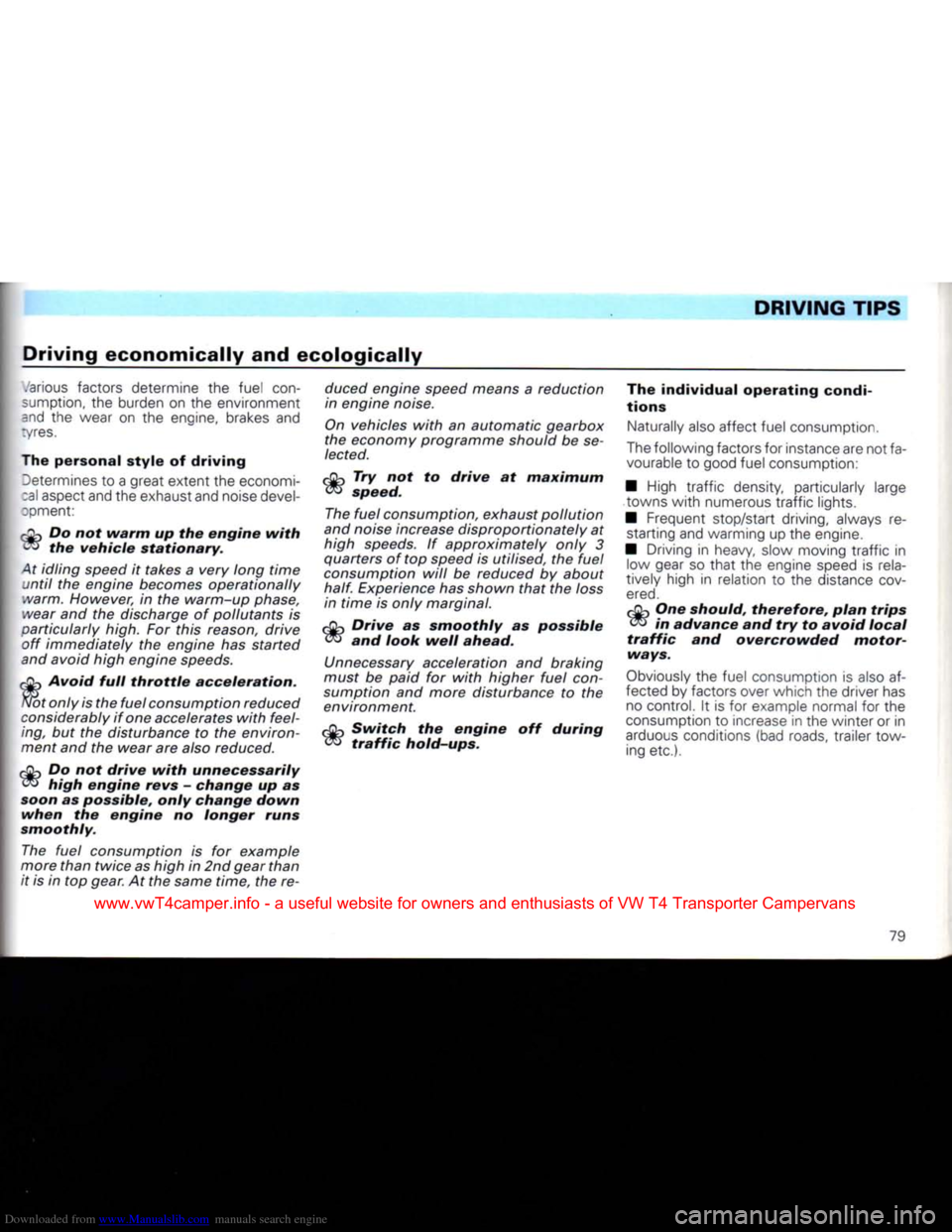
Downloaded from www.Manualslib.com manuals search engine
DRIVING
TIPS
Driving economically and ecologically
.'arious
factors determine the fuel
con
sumption,
the burden on the environment
and
the wear on the engine, brakes and
lyres.
The personal style of driving
Determines
to a great extent the economi-
:al
aspect and the exhaust and noise
devel
opment:
jOp
Do not
warm
up the
engine
with
W» the
vehicle
stationary.
At idling speed it takes a very long
time
until
the engine becomes operationally
warm. However, in the warm-up phase,
wear and the discharge of pollutants is
oarticularly high. For
this
reason, drive
off immediately the engine has started
and avoid
high
engine speeds.
f
h Avoid
full
throttle
acceleration.
of only is the
fuel
consumption reduced
considerably
if one accelerates
with
feel
ing, but the disturbance to the environ
ment
and the wear are also reduced.
rflri
Do not
drive
with
unnecessarily
high
engine
revs
-
change
up as
soon as possible,
only
change
down
when
the
engine
no
longer
runs
smoothly.
The
fuel
consumption is for example
more
than
twice as
high
in 2nd gear
than
it is in top
gear.
At the same
time,
the re duced engine speed means a reduction
in engine noise.
On vehicles
with
an automatic gearbox
the economy programme should be se
lected.
c^p
Try not to
drive
at
maximum
TO
speed.
The
fuel
consumption, exhaust pollution
and noise increase disproportionately at
high
speeds. If approximately only 3
quarters of top speed is utilised, the
fuel
consumption
will
be reduced by about
half.
Experience has shown
that
the loss in
time
is only marginal.
c
j-,
Drive
as
smoothly
as possible and
look
well
ahead.
Unnecessary
acceleration and braking
must
be paid for
with
higher
fuel
con
sumption and more disturbance to the environment.
Switch
the
engine
off
during
hold-ups. The individual
operating
condi
tions
Naturally
also
affect fuel consumption.
The
following factors for instance are not fa
vourable
to good fuel consumption:
•
High traffic density, particularly large
.towns with numerous traffic lights.
•
Frequent stop/start driving, always restarting and warming up the engine.
•
Driving in heavy, slow moving traffic in
low
gear so that the engine speed is
rela
tively high in relation to the distance cov
ered.
CQ~, One
should,
therefore,
plan
trips
in
advance
and try to
avoid
local
traffic
and
overcrowded
motor
ways.
Obviously
the fuel consumption is
also
af
fected
by factors over which the driver has
no
control. It is for example normal for the
consumption
to increase in the winter or in
arduous
conditions (bad roads, trailer tow ing etc.).
79
www.vwT4camper.info - a useful website for owners and enthusiasts of VW T4 Transporter Campervans
Page 101 of 164

Downloaded from www.Manualslib.com manuals search engine
GENERAL
MAINTENANCE
Gearbox
oil
Specifications
Manual
gearbox
and
final
drive
•
Gear
oil,
API-GL
4, SAE 80 or
•
Gear
oil, G 50, SAE 75 W-90
Automatic
gearbox
• Final drive:
Gear
oil, G 50, SAE 75 W-90 I Gearbox part: ATF Dexron®
Checking oil
level
rVith
a
manual
gearbox
and
final
drive
the oil level does not need checking.
'.ith the
automatic
gearbox
the oil
•e.
el in the final drive does not need check- *g either.
"he
ATF
level
in
gearbox
part
must ": .'/ever be checked in between the inter-
•BS
given in Service Schedule. To do this
ire vehicle must be standing on a level sur-
fe:e.
The
level must only be checked when
He ATF is
warm.
(Approximately 10 km
Irrer
starting from
cold,
the ATF has re
tted the required temperature.) If fluid is
l:: :: or too hot the reading will be incorrect.
1
he engine must be running at idling
speed,
the handbrake must be applied and the se lector lever at "N".
To
check, pull dipstick (see Fig.) out, wipe
with a clean lint-free rag and then insert it
fully
again.
Pull
the dipstick out and check ATF
level.
When
the ATF is
warm
the
level
must
be
between
the two
marks
- other
wise
the vehicle must be taken to a
Volks
wagen
dealer without delay so that they can
find the reason for the incorrect
level.
It is not sufficient to merely top up or drain off
ATF.
Changing oil
For
the manual
gearbox
with
final
drive
the oil does not need changing.
For the
automatic
gearbox
the :
the final drive does not need
chariC-g
either. The ATF in gearbox part must how
ever
be changed at the intervals given in
Service
Schedule.
Because of the disposal
prob
lems,
the
special
tools
necessary
and the
specialist
knowledge
re
quired,
the ATF
changing
should
preferably
be
done
by a
Volkswagen
dealer.
Notes
•
When
there
is no
lubricant
in the
manual
or
automatic
gearbox,
the
engine
must
not be
started
and the
vehicle may only be
towed
with
the
driving
wheels
lifted.
• No
additives
may be
mixed
with
the lubricants.
www.vwT4camper.info - a useful website for owners and enthusiasts of VW T4 Transporter Campervans
Page 125 of 164

Downloaded from www.Manualslib.com manuals search engine
DO-IT-YOURSELF
Fuse
layout
<*'om
left
to
right)
No.
Component
A11
' - Dipped beam
left,
headlight range control
left
10
I- Dipped beam
right,
headlight range control
right
10
3-
Instrument
and number plate lighting 10
--
Rear
wiper, seat heating 15
5-
Windscreen wiper,
windscreen and rear window
washer/elec.
heated
washer
jets 15
5-
Blower, air conditioner 30
/- Tail and side
light
right,
engine compartment
light
10
3-
Tail and side
light
left
10
9-
Rear
window heating, mirror heating 20
10-
Fog lights, rear fog
light
15
II- High beam
left,
high beam
warning lamp 10
12-
High beam
right
10
13-
Horn, radiator fan (run-on) 10
1 Ampere No.
Component
A
14-
Reversing lights, electric outside mirrors, sliding/tilting
roof,
shift pattern auto, gearbox,
cruise
control system
(cancel contacts on the brake
and clutch pedal) 10
15-
Engine electronics 10
16-
Warning lamps,
dash
panel insert,
glove box
light
15
17-
Turn signals 10
18-
Electric fuel pump,
Lambda
probe 20
19-
Radiator fan, air conditioner 30
20-
Brake lights 10
21-
Interior
and luggage compartment lights, make-up mirror
light,
clock,
radio,
central locking 15
22-
Cigarette lighter 10
Additional
fuses
(in separate holders)
• above the relays A11
Fuse
for electric windows 20
• In the engine compartment on the bulk
head
above the brake servo:
Glow
plugs21 50
• Under the driver's seat
Fuse
for additional water heater 10
Fuse
for heater blower .30
Fuse
for water heater
glow plug 20
Fuse
for auxiliary heater3' 25
Fuse colour code:
Red:
10 Ampere
Blue:
15 Ampere
Yellow:
20 Ampere
Green:
30 Ampere
21 This fuse should only be renewed by
a
Volks
wagen dealer.
31 On vehicles
with
swivelling seats this fuse
can
be found in the side
trim
behind the
driver's seat.
123
www.vwT4camper.info - a useful website for owners and enthusiasts of VW T4 Transporter Campervans
Page 134 of 164
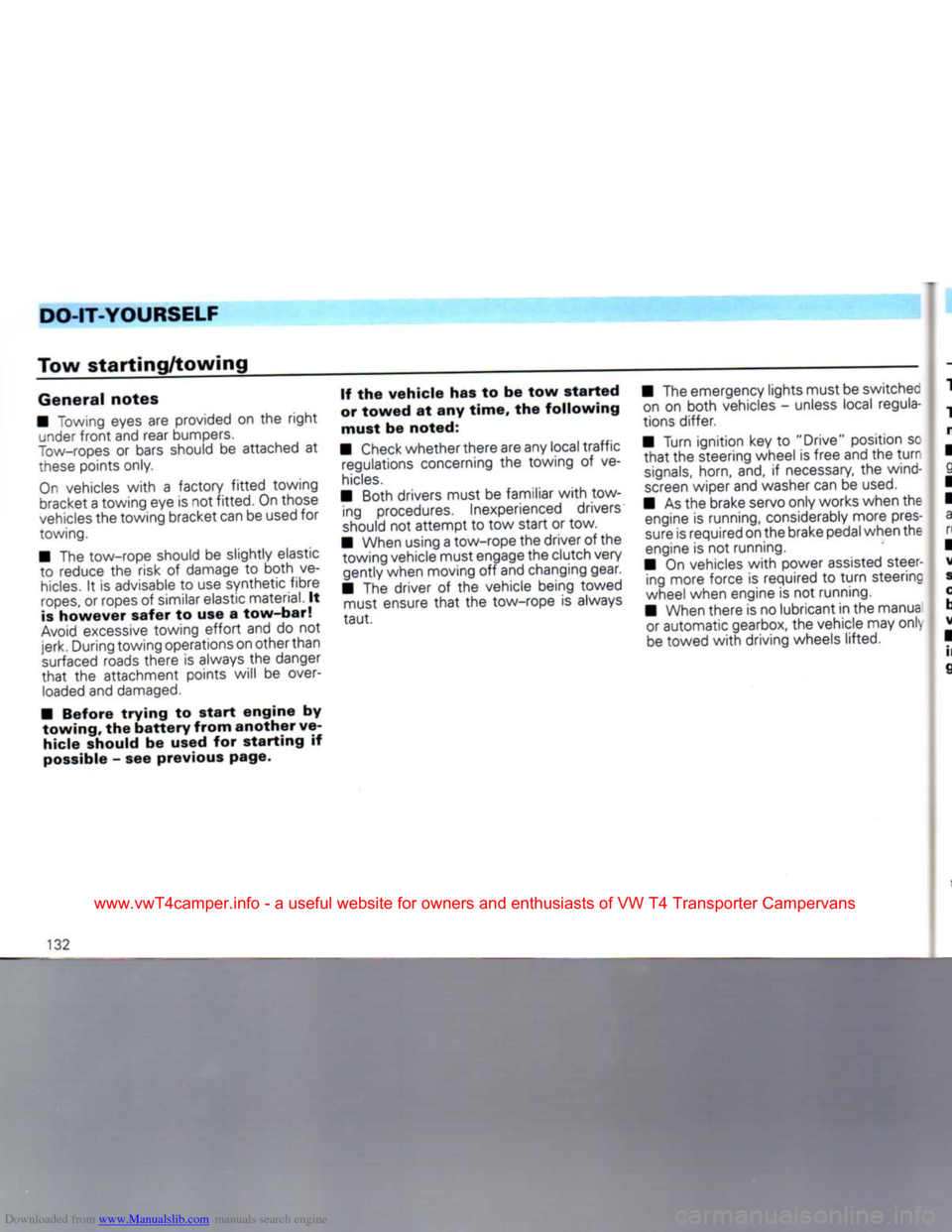
Downloaded from www.Manualslib.com manuals search engine
DO-IT-YOURSELF
Tow
starting/towing
General
notes
• "owing eyes are provided on the
right
under
front
and rear bumpers.
Tow-ropes
or bars should be attached at
these
points only.
On
vehicles
with
a factory
fitted
towing bracket a towing eye is not fitted. On those
vehicles
the towing bracket can be used for
towing.
• The tow-rope should be slightly elastic to reduce the risk of damage to both ve
hicles.
It is advisable to use synthetic fibre
ropes,
or ropes of similar elastic material. It
is
however
safer
to use a
tow-bar!
Avoid
excessive towing
effort
and do not
jerk.
During towing operations on other than
surfaced
roads there is always the danger
that
the attachment points will be over
loaded
and damaged.
•
Before
trying
to
start
engine
by
towing,
the
battery
from
another
ve
hicle
should be used for
starting
if
possible - see previous page. If the
vehicle
has to be tow
started
or
towed
at any
time,
the
following
must
be noted:
•
Check
whether there are any local traffic regulations concerning the towing of ve
hicles.
• Both drivers must be familiar
with
tow ing procedures. Inexperienced drivers
should
not attempt to tow start or tow.
• When using a tow-rope the driver of the towing vehicle must engage the clutch very gently when moving off and changing gear.
• The driver of the vehicle being towed must ensure
that
the tow-rope is always
taut.
• The emergency lights must be switchec
on on both vehicles - unless local regula
tions differ.
• Turn ignition key to "Drive" position sc
that
the steering wheel is free and the
turr
signals,
horn, and, if necessary, the wind
screen
wiper and washer can be
used.
• As the brake servo only works when the engine is running, considerably more pres
sure
is required on the brake pedal when the
engine is not running.
• On vehicles
with
power assisted steer ing more force is required to
turn
steering
wheel when engine is not running.
• When there is no lubricant in the manua or automatic gearbox, the vehicle may only
be
towed
with
driving wheels lifted.
132
www.vwT4camper.info - a useful website for owners and enthusiasts of VW T4 Transporter Campervans
Page 135 of 164
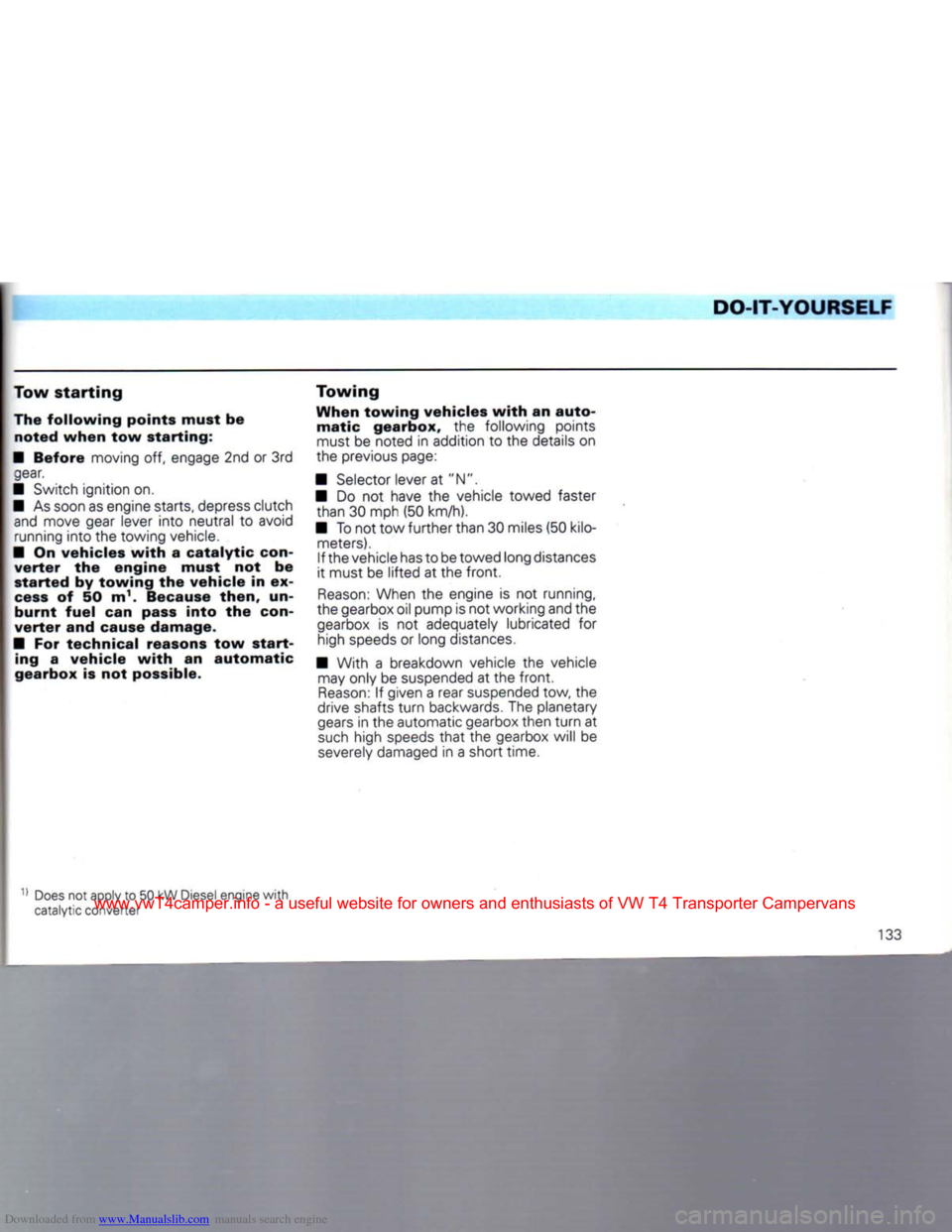
Downloaded from www.Manualslib.com manuals search engine
DO-IT-YOURSELF
Tow
starting
The
following
points
must
be
noted
when
tow
starting:
•
Before
moving off, engage 2nd or 3rd gear.
• Switch ignition on.
• As soon as engine starts, depress clutch and move gear lever
into
neutral to avoid running
into
the towing vehicle.
• On
vehicles
with
a
catalytic
con
verter
the
engine
must
not be
started
by
towing
the
vehicle
in ex
cess of 50 m1. Because
then,
un-
burnt
fuel
can pass
into
the con
verter
and cause
damage.
• For
technical
reasons tow
start
ing a
vehicle
with
an
automatic
gearbox
is not possible.
Towing
When
towing
vehicles
with
an
auto
matic
gearbox,
the following points must be noted in addition to the details on
the previous page:
• Selector lever at "N".
• Do not have the vehicle towed faster than 30 mph (50 km/h).
• To not tow
further
than 30 miles (50 kilo meters). If the vehicle has to be towed long distances
it must be
lifted
at the
front.
Reason:
When the engine is not running,
the gearbox oil pump is not working and the
gearbox is not adequately lubricated for high speeds or long distances.
• With a breakdown vehicle the vehicle may only be suspended at the
front.
Reason:
If given a rear suspended tow, the
drive shafts
turn
backwards. The planetary
gears
in the automatic gearbox then
turn
at
such
high speeds
that
the gearbox will be
severely
damaged in a short time.
Does
not apply to 50 kW Diesel engine
with
catalytic converter
133
www.vwT4camper.info - a useful website for owners and enthusiasts of VW T4 Transporter Campervans
Page 136 of 164
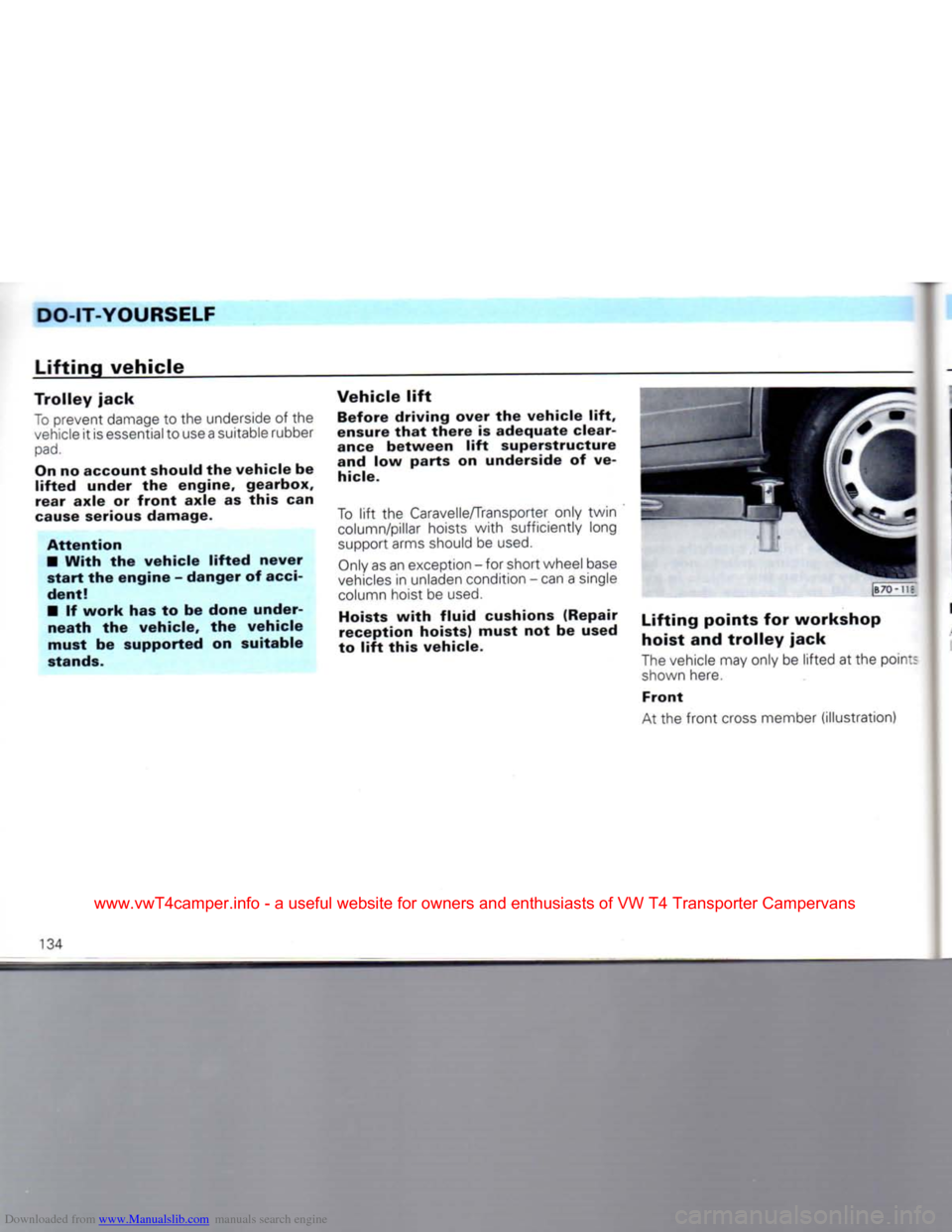
Downloaded from www.Manualslib.com manuals search engine
DO-IT-YOURSELF
Lifting
vehicle
Trolley
jack
To
prevent damage to the underside of the vehicle it is essential to use
a
suitable rubber
On
no account should the vehicle be
lifted
under the engine, gearbox,
rear axle or
front
axle as this can
cause
serious damage.
Attention
• With the vehicle
lifted
never start the engine - danger of
acci
dent!
• If work has to be done under neath the vehicle, the vehicle
must be supported on suitable
stands.
Vehicle
lift
Before driving over the vehicle
lift,
ensure
that
there is adequate clear
ance
between
lift
superstructure
and low parts on underside of ve
hicle.
To
lift
the Caravelle/Transporter only
twin
column/pillar hoists
with
sufficiently long
support arms should be
used.
Only
as an exception - for short wheel base
vehicles
in unladen condition - can a single
column hoist be
used.
Hoists
with
fluid cushions (Repair reception hoists) must not be used
to
lift
this vehicle.
Lifting
points
for
workshop
hoist
and
trolley
jack
The vehicle may only be
lifted
at the poin:
shown here.
Front
At the
front
cross member (illustration) At
us
134
www.vwT4camper.info - a useful website for owners and enthusiasts of VW T4 Transporter Campervans
Page 141 of 164
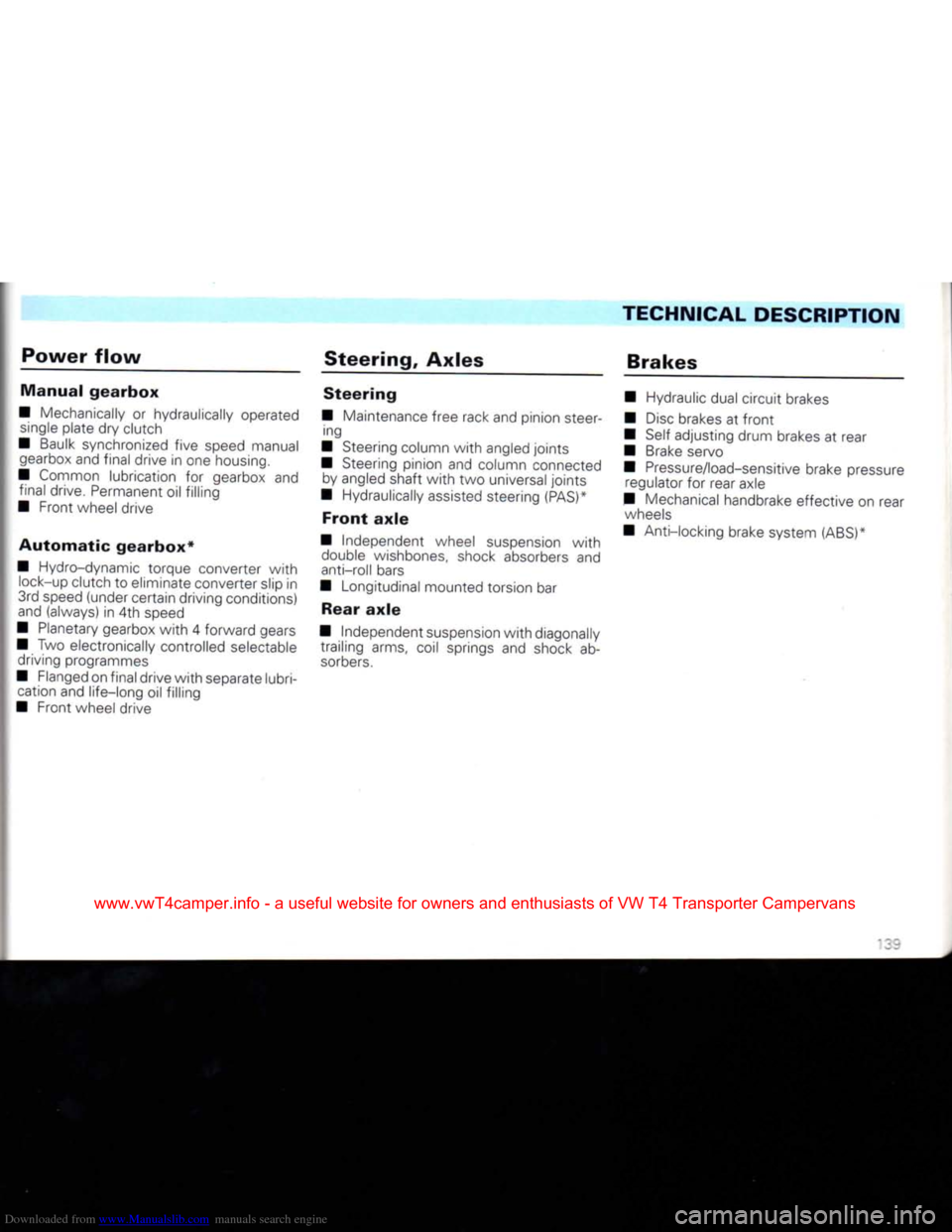
Downloaded from www.Manualslib.com manuals search engine
TECHNICAL
DESCRIPTION
Power
flow
Manual
gearbox
• Mechanically or hydraulically operated single plate dry clutch
• Baulk synchronized five speed manual gearbox and final drive in one housing.
• Common lubrication for gearbox and final drive. Permanent oil filling
• Front wheel drive
Automatic
gearbox*
• Hydro-dynamic torque converter
with
lock-up clutch to eliminate converter slip in
3rd speed (under certain driving conditions)
and (always) in 4th speed
• Planetary gearbox
with
4 forward gears
• Two electronically controlled selectable driving programmes
• Flanged on final drive
with
separate lubri cation and life-long oil filling
• Front wheel drive
Steering,
Axles
Steering
• Maintenance free rack and pinion steer ing
• Steering column
with
angled joints
• Steering pinion and column connected by angled shaft
with
two universal joints
• Hydraulically assisted steering
(PAS)*
Front
axle
• Independent wheel suspension
with
double wishbones, shock absorbers and
anti-roll bars
• Longitudinal mounted torsion bar
Rear
axle
• Independent suspension
with
diagonally trailing arms, coil springs and shock ab
sorbers.
Brakes
• Hydraulic dual circuit brakes
•
Disc
brakes at
front
• Self adjusting drum brakes at rear
• Brake servo
• Pressure/load-sensitive brake pressure regulator for rear axle
• Mechanical handbrake effective on rear wheels
• Anti-locking brake system
(ABS)*
www.vwT4camper.info - a useful website for owners and enthusiasts of VW T4 Transporter Campervans
Page 144 of 164
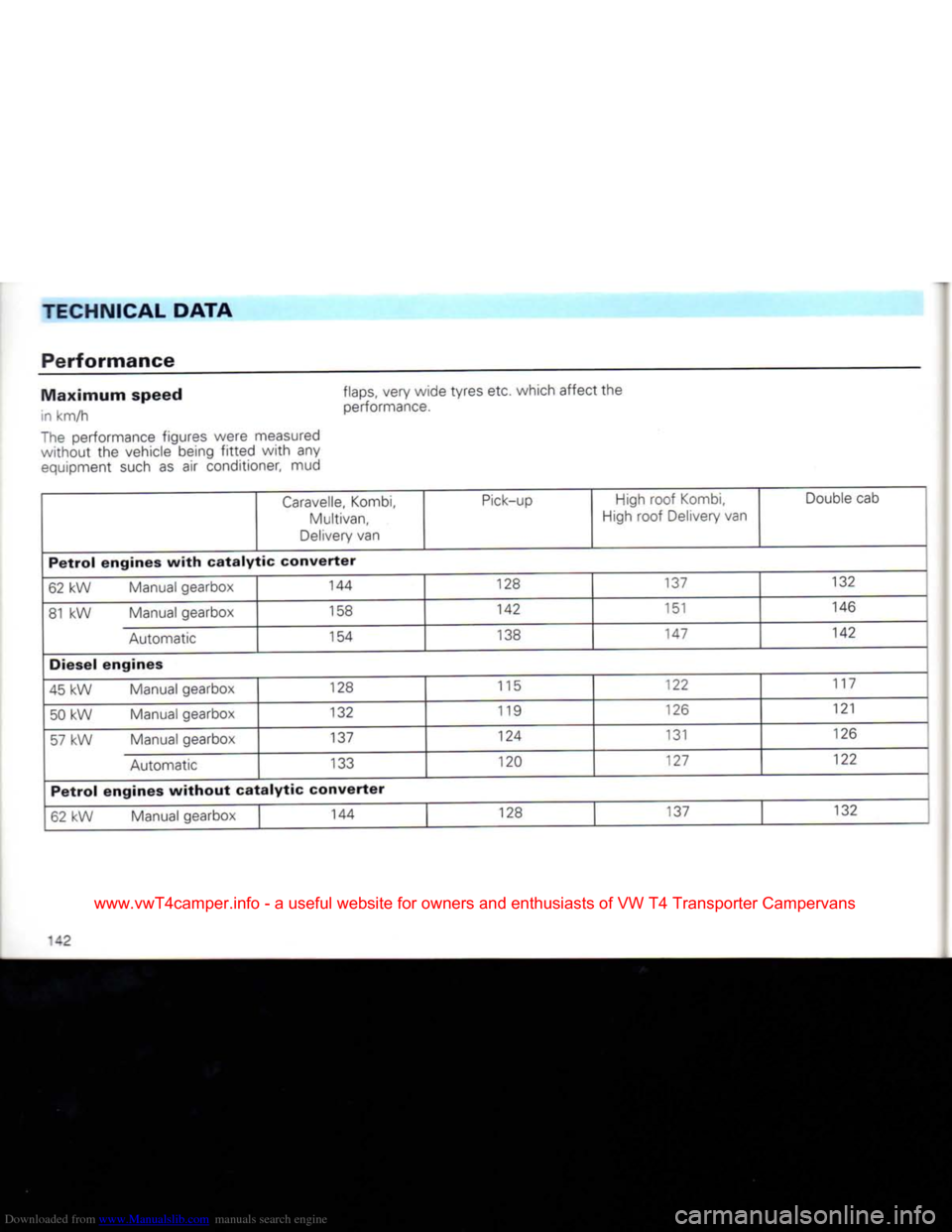
Downloaded from www.Manualslib.com manuals search engine
TECHNICAL DATA
Performance
Maximum
speed flaps,
very
wide
tyres
etc. which affect the
in
km/h performance.
The performance figures were measured
without the vehicle being fitted with any
equipment
such as air conditioner, mud
Caravelle, Kombi,
Multivan,
Delivery van
Pick-up
High
roof Kombi,
High
roof Delivery van
Double
cab
Petrol
engines
with
catalytic
converter
62 kW Manual gearbox 144 128
137 132
81 kW Manual gearbox 158 142
151 146
Automatic
154
138 147 142
Diesel
engines
45 kW Manual gearbox 128 115
122 117
50 kW Manual gearbox 132 119
126 121
57 kW Manual gearbox 137 124
131 126
Automatic
133 120
127 122
Petrol
engines
without
catalytic
converter
62 kW Manual gearbox 144
128 137
132
www.vwT4camper.info - a useful website for owners and enthusiasts of VW T4 Transporter Campervans